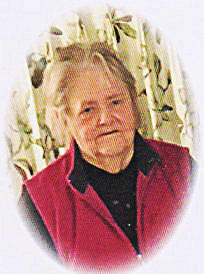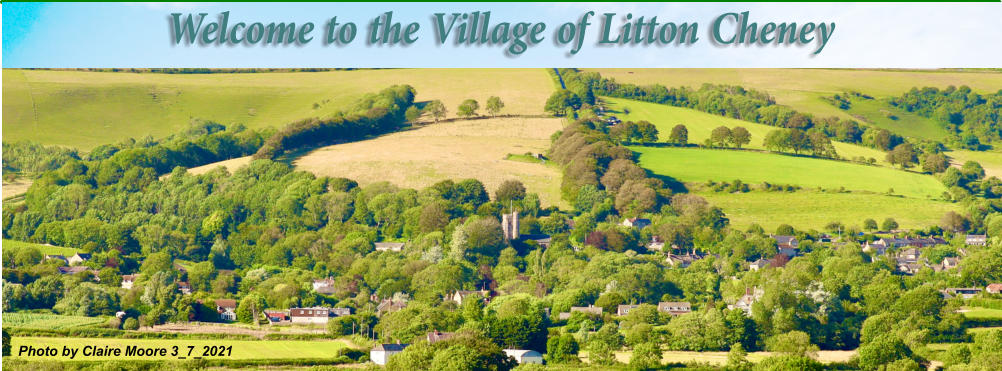GORDON MOXOM 1937-2016
The following eulogy was given at his memorial service on Tuesday 13th December 2016.
Firstly, Barbara and Alan have asked me to say thank you to all of you for coming here today to pay your respects and say farewell
to Gordon. In turn, I would like to thank them for the honour of being asked to say these few words about the man we all knew and
admired.
Gordon was born at Whitethorn Cottage, Litton Cheney, in April 1937. He had a sister June
who pre-deceased him. He attended Thorners School and then a secondary school in
Allington, which no longer exists. After school he took an apprenticeship at Sharptones
Engineering, which has also subsequently disappeared. Whether Gordon had anything to do
with the demise of these two establishments we shall never know – maybe it was just co-
incidence!
Gordon met Barbara in 1958 on Chesil Beach and they were married in 1962. Their son Alan
was born in 1964.
Gordon was a very private man, not one for a night out with the boys playing skittles or darts.
At one time he was a keen bell ringer and he also enjoyed fishing and scuba diving with his
friend Mike Stoodley. However, his two overwhelming passions were his family and his work.
He was immensely proud of his two grand-daughters Natalie and Sophie especially when they
both obtained university degrees.
Gordon’s father Charlie worked at Whiteheads Torpedo factory at Wyke Regis during the war and
also, with Gordon’s mother Joyce, ran a bed and breakfast establishment in Weymouth.
Charlie Moxom established a workshop come garage next to Grove Cottages in the early 1950’s and
Gordon joined him in 1958, at the age of 21, following his apprenticeship. Now, as anyone who knew
Gordon would imagine, he was not one to sit back and spend the rest of his life doing simple routine
jobs. So it was in 1962 that A C Moxom Limited, Precision Engineers, was officially registered at
Companies House, Gordon and Barbara being the only shareholders.
Over the next few years the expanding business outgrew the premises next to Grove Cottages so, in
1971, additional facilities were added on the opposite side of Chalkpit Lane. A C Moxom Limited
continued to provide employment in the village over the next 39 years, until it was closed in March
2010, mainly due to a lack of suitably skilled labour.
Talking to ex-employees, it is clear that Gordon was regarded very much as a friend as well as an
employer. As one of them told me “I was sent there by the labour exchange in 1971. When I got
home my wife asked me if the job was OK. I said it will do until something better comes along. I
stayed there until I retired 34 years later. He enjoyed the challenge of taking on work that others
refused to consider. We used to think he was mad at times when he came back with what appeared to be some impossible job,
but somehow we always seemed to find a solution”.
Gordon always had a bee in had bonnet about ‘not being educated’. It’s true, he may not have had a piece of
paper proving he was good at passing exams, but he was an extremely competent self-taught engineer. In
seeking solutions to the ‘impossible’ jobs he took on he became not only a skilled metalworker but also a very
able metallurgist. Another skill he mastered was the art of spray welding stellite alloy onto surfaces to harden
them, sometimes solving problems that Deloro Stellite themselves could not. He once told me that Deloro
Stellite offered to keep Moxom Engineering fully employed on this work alone, possibly making him a very rich
man. Of course, this would have been too repetitive and boring for Gordon so he turned them down.
During retirement he used his skills building a magnificent quarter scale model of a Burrell steam engine. The
plans he bought to help him proved to be somewhat less than accurate so Gordon had to re-design a lot of
parts himself. In doing so he had to learn all about the mysteries of steam engineering. He spent a lot of time
trying to explain to me the nuances of slide valves, safety valves, boiler pressures etc. etc. but I’m afraid it was
wasted on me. I was extremely proud, however, to be allowed to help him rivet the tracks onto the main drive
wheels.
I had the privilege of knowing Gordon for over 40 years. We used to meet at the Manor
Hotel in West Bexington on Wednesday evenings when Gordon’s father-in-law, Fred,
used to run the bar for Charlie Groves, of Groves Nursery, who owned the Manor at that
time. Fred was a great character who delighted in winding up the holiday makers.
When asked by some blazer adorned individual why there was no mint in his Pimms
Fred said “there’s plenty out there in the garden – just help yourself”.
Gordon and I had a boat propelled by a small Seagull engine which we kept on Chesil
Beach and used for fishing trips. What the health and safety brigade would make of us
these days I dread to think. No life jackets, an engine which would not go against the
tide, no bucket to bail it out and a crate of beer under the seats – I’m sure they would
have tried to ban us “for our own good” of course.Like Fred, Gordon also had a dry sense of humour. Keeping the boat on the
pebbles meant that the seams used to open up and allow water to trickle in. One night he said to me “if we’re going out fishing at
the weekend we ought to put the boat in the water to let it plim up”. Now, you can imagine the puzzlement of the holiday makers
wondering why a couple of idiots were sat on the pebbles, holding the mooring rope,
watching their boat bobbing up and down whilst drinking bottles of beer. Eventually it
became too much for one of them and he said “something wrong with your boat”? “No”,
Gordon replied”, “it’s what is known in Dorset as a golfing boat – it’s got 18 holes in it”.
So, as we say “farewell” to Gordon for one last time, I’m sure many of you share similar
happy memories not only of his sense of humour but his kindness, thoughtfulness and
undeniable generosity. I’m sure he would not want us to mourn his passing but to give
thanks for his life and work whilst expressing our condolences to Barbara and the
family.
Goodbye my old friend, you will be sadly missed but never forgotten.
Thank you.
David Hearn
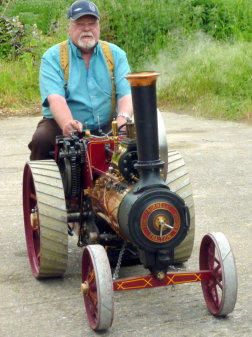
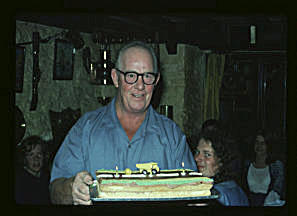
Fred Wilmington
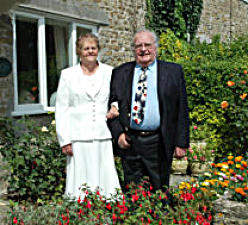
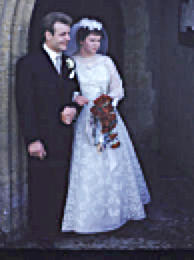
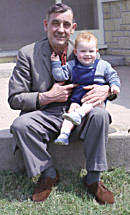
Charlie & Alan
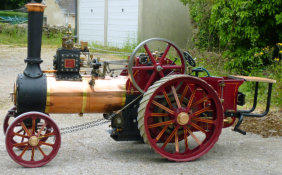
JOHN RANDALL 1925-2017
You
will
all
have
your
own
personal
memories
of
John
Randall.
However
I
would
like
to
remind
you
of
the
man
I
first
met
35
years
ago and whom I had the pleasure of meeting many times thereafter.
John
was
of
slight
build
and
stood
ramrod
straight.
He
had
the
weather
wom
face
and
the
fiat
tweed
cap
of
a
countryman.
He
would
be
wearing
a
collar
and
tie
under
his
well
brushed
tweed
ratcatcher
jacket.
Below
this
he
would
wear
breeches,
leather
gaiters
and
boots.
What
struck
one
most
was
the
quizzical
twinkle
in
his
eyes
and
the
amazing
high
polish
on
his
brown
gaiters
and
boots.
John
would
be
about
to
get
into
his
white
van
which
was
not
as
well
polished
as
his
boots
and
gaiters.
This
contained
all
that
he
needed
for
his
joumey
whether
it
was
to
London,
to
judge
at
a
show,
visit
a
market,
give
advice
or
any
of
the
thousand
and one other matters associated with sheep or heavy horses.
John
was
generous
with
his
time
and
enjoyed
talking
and
explaining
his
twin
loves
of
heavy
horses
and
sheep
to
anybody,
ensuring
that
his
expertise
was
passed
on.
This
was
the
same
approach
he
used
whether
he
was
talking
to
the
Queen,
Prince
Philip,
the
Prince
of
Wales,
the
Princess
Royal,
The
Chairman
of
Youngs
Brewery
or
the
Colonel
of
the
Dorset
Yeomanry.
He
would
always
talk
to
the
young
be
they
at
the
ring
side
of
a
show,
the
village
fete
or
when
he
ran
his
legendry
lamb
roast
barbeque.
All his friends needed his advice which he so freely gave.
He
was
at
peace
with
the
world,
not
afraid
to
express
his
opinion
and
very
willing
to
listen
to
yours
and
then
tell
you
that
you
were
wrong.
So
with
the
help
of
Dorothy,
Carol
and
Russell
who
wrote
most
of
what
I
will
read
I
will
try
and
explain
to
you
how
John
became the great shepherd he was.
John
was
bom
at
Beckington,
a
village
to
the
North
of
Frome,
in
Somerset.
His
father
Richard
was
a
carpenter,
wheelright
and
undertaker,
his
mother
Martha
a
cheesemaker.
He
was
educated
at
Beckington
Primary
and
then
at
Frome
Grammar
School
where
he
excelled
at
cricket
and
kept
wicket
for
both
the
school
and
village
teams.
He
and
his
elder
brother
Stewart
had
a
true
rural upbringing with all that included in those days and John was quite inventive.
At
an
early
age
John
showed
a
keen
interest
in
farming,
working
holidays
and
week
ends
for
Russell
Frankes
a
local
dairy
farmer.
He
left
school
at
15
and
moved
to
Salway
Ash
to
be
with
his
Uncle
Bert
and
Aunt
Rose
who
had
Cursey
Farm.
This
was
where
John’s passion for sheep started. A neighbour, Percy Warren, had a flock of Dorset Homs.
It
was
here
too
that
John
met
Dorothy
and
romance
blossomed.
John
had
saved
his
pennies
and
had
a
car
but,
so
that
he
could
take
Dorothy
out,
he
need
extra
cash
and
this
came
from
rabbiting
at
which,
as
with
so
many
other
things,
he
was
a
dab
hand
with
purse
and
long
nets
as
well
as
his
trusty
12
bore
and
not
forgetting
Fido
bred
by
Mr
Coombes
here
in
Litton.
No
rabbit
was
safe.
One
Boxing
Day
he
and
a
mate
went
to
Colmers
Hill
and
after
52
shots
between
them
retumed
with
53
rabbits.
The
dog
caught
one.
Time
went
by
and
in
1951
John
and
Dorothy
were
married
at
Netherbury
Church
and
the
following
year
David
arrived
followed
three years later by Russell
At
this
time
John’s
love
of
sheep
expanded
and
his
shepherding
career
took
off.
After
various
jobs
he
went
to
work
for
Charles
Borough
at
Manor
Farm,
Halse
near
Bishops
Lydeard
once
again
in
Somerset.
Dorset
Downs
of
course
and
all
went
well
until
the
bitter winter of 1963 when he left after a disagreement as to whether the sheep or the cows should have the best food.
John
then
retumed
to
Dorset
as
Head
Shepherd
to
Bill
Hooper
at
Winfrith
Newburgh
where
the
sheep
did
take
priority
over
most
other things.
John
wanted
to
further
his
career
and
took
a
job
managing
a
mixed
farm,
sheep,
beef
and
corn,
in
East
Sussex
but
the
sheep
were
Romneys.
Then
back
to
Dorset
as
shepherd
for
Rex
Loveless
at
Piddlehinton
and
so
onto
the
Dorset
College
of
Agriculture
at
Kingston
Maurward which he described as quite an eye opener more so for the lecturers and students than for John.
After
the
DCA
sold
their
sheep
flock
John
temporarily
changed
tack
and
looked
after
a
show
team
of
Shire
Horses,
his
other
great
passion,
breeding,
breaking
and
showing
the
horses
and
very
narrowly
missing
out
on
qualifying
for
the
Horse
of
the
Year
Show
at
Olympia in London a couple of times.
In
1982
John
moved
to
Litton
and
back
to
his
fïrst
love
sheep.
This
time
he
worked
for
himself
contract
sheering,
trimming
and
whatever else he was called to do.
About
a
year
after
his
move,
whilst
in
deep
conversation
with
Walt
Borough,
he
said
that
it
would
take
5
years
to
start
a
flock
and
breed
a
champion.
So
the
gauntlet
was
down,
John
bought
5
ewes,
rented
a
few
acres
and
started
the
Bride
Valley
flock
of
pedigree
Dorset
Down
Sheep
and,
during
the
fifth
year,
a
Championship
Prize
was
won.
From
then
on
the
flock
grew
and
Champions were bred and very high prices paid when these animais were sold.
By
this
time
grandchildren
were
on
the
scene
and
all
were
roped
in
to
help
whether
they
wanted
to
or
not.
Stephen,
more
commonly
known
as
Nipper,
was
a
little
different.
He
was
always
ready
to
go
especially
when
he
was
big
enough
to
open
gates
and
fetch
and
carry.
Of
course
the
bag
of
sweets
in
the
van
always
helped.
John
and
his
mate
would
go
off
to
do
the
sheep
and
retum
when
it suited them.
One
moming
Carol
told
John
that
Nipper
had
to
properly
exercise
his
dog,
a
black
and
white
Border
Collie
of
course,
whilst
they
were
out.
When
they
retumed
Carol
asked
John
if
they
had
exercised
the
dog.
Oh
yes
said
John
followed
by
a
big
grin.
It
tumed
out
that
Nipper
sat
in
the
back
of
the
van
with
a
piece
of
rope
as
a
lead,
so
with
the
back
doors
open
and
John
driving
the
dog
ran
behind. This tumed into a regular event.
John
carried
on
shepherding
for
many
years
and
eventually
gave
up
in
2003
but
he
did
not
lose
his
love
and
enthusiasm
for
sheep.
He
did
not
give
in.
He
carried
on
with
the
Dorset
Downs
Sheep
Breeders
Association,
helping
to
organize
the
annual
breed
show
and
as
a
committee
member
until
2015. The telephone was his lifeline with people ringing for a chat or advice.
Over
the
years
John
achieved
many
things
of
which
he
was
proud.
He
met
most
of
the
Royal
Family.
He
was
presented
to
the
Queen.
He
met
the
Duke
of
Edinburgh
and
The
Prince
of
Wales
many
times.
He
served
on
the
Royal
Smithfield
Show
Committee
with
the
Princess
Royal
as
President.
He
was
on
very
good
ternis with Lady Aldington and acquainted with Lord Whitelaw selling him many a ram.
John
had
a
long
association
with
Young’s
Brewery
in
Wandsworth
because,
of
course,
their
mascot
was
a
Dorset
Hom
Ram
called
Ramrod
who
had
to
be
trimmed
several
times
a
year
to
keep
him
looking
good.
This
meant
regular
visits
to
the
Brewery
and
these
always
ended
in
the
Sample
Room.
At
Christmas
he
would
take
a
ewe
and
lambs
to
the
Brewery
for
their
Christmas
crib
which
raised money for the local children’s home. Again a visit to the Sample Room and a good sélection of beer for the retum joumey.
John
also
had
a
fine
relationship
with
the
Dorset
Yeomanry
who
are
now
the
Wessex
Rifles.
Their
mascot
was
also
a
Dorset
Hom
Ram which meant visits to Bovington Camp and of course a detour on the way home via the Officer’s Mess.
John
served
on
various
judging
panels
and
judged
at
many
of
the
major
and
minor
shows
both
as
a
breed
and
an
interbreed
judge.
Dorset
Down
Sheep
were
his
overriding
passion
and
over
the
years
he
won
countless
prizes,
Many
many
Champions,
Supreme
Champions and Interbreed Champions.
John
wrote
two
books
and
made
a
video
on
how
to
show
sheep
and
how
to
trim
their
feet.
He
appeared
on
télévision
including
with
Chris Evans on Zig and Zag.
As
well
as
his
love
of
sheep
in
general,
and
Dorset
Downs
especially,
John
will
be
remembered
for
the
help
and
advice
he
gave
to
many
to
help
them
on
their
way
in
the
sheep
world,
and
of
course
his
britches
and
highly
polished
boots
and
leggings
lovingly
prepared for him by Dorothy. Finally John enjoyed an ample dram whenever the occasion arose.
Thank you John for enriching all our lives.
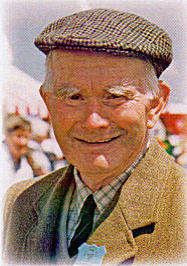
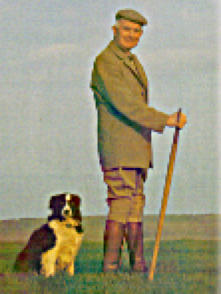
By Robin Barbour
FUNERAL ADDRESS – Monday, 27
th
February 2017
By David Hearn
FUNERAL ADDRESS – Tuesday, 13
th
December 2016
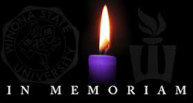




IN MEMORIAM - CONTEMPORARY
Select Name
ABOUT LITTON CHENEY



Item by his son Russell
‘My father’s family had a business at Beckington, near Frome, where they were
carpenters/joiners and wheelwrights. After he’d left Frome Grammar School,
father came to Salwayash to stay with his uncle who ran Lower Kershay Farm,
which is where he met Mother. At that time Father’s passion for sheep was
inspired by neighbouring farmer Percy Warren who kept Dorset Horns. The
business at Beckington has been going for generations; Father’s mother was a
cheesemaker and farmed in her own right, as did his aunts.
There are two trades in our family: carpenters/wheelwrights/undertakers, which
often went hand in hand, and farming. Father’s uncle, who he worked with, was
actually born here in our house in Litton Cheney, where his father rented land
locally for dairying. And I’ve got an older brother, who followed in Father’s
footsteps and went shepherding.
As soon as I was able to carry half a bale of hay I had to go and help Father feed
sheep. All his life, the topic of conversation with him was either sheep, heavy
horses or farming, in that order. At 13 I was driving tractors, haymaking and
harvesting, and helping with sheep work. Father’s work took him all round Dorset,
and beyond. He worked for Charlie Borough’s at Halse in Somerset, then for Bill
Hooper at Winfrith Newburgh, with Pedigree Dorset Downs. He went to Sussex
looking after Kent Romney ewes, then to Rex Loveless’s at Piddlehinton with Dorset Downs again, then to Kingston Maurward to
work with the college’s Dorset Horn flock, until they were sold. That was an old flock, a good one, and when Father was showing
them he was giving Fooks’s at Powerstock, famous Dorset Horn breeders, a run for their money and occasionally beating them.
He was a familiar sight at agricultural shows and markets, probably known to most Dorset farmers at the time in his flat cap, collar
and tie, britches and highly polished brown leather gaiters. He had met members of the Royal Family, including HRH the Queen,
the Chairman of Youngs Brewery and the Colonel of the Dorset Yeomanry, all of whom he advised about sheep, and would
generally listen carefully to what you had to say about a farming matter before politely telling you how you were wrong. In 1982
after being made redundant from Kingston Maurward, he had the chance to rent a bit of ground in Litton Cheney, so we moved
back here and he started his own small flock of Dorset Downs.
I went in the other family trade direction and have been a carpenter joiner all my life, and we do some wheelwrighting. From a
young age I wanted to be a carpenter. With a piece of wood, a hammer and some nails, I was happy. After I left school I got a job
in Dorchester with an old building firm called CE Slade’s, based down in Millers Close. That was in the days when there were
some decent building firms in Dorchester, like Cake’s, Ricardo’s, Angell’s, all very good builders with their own joinery shops. I
started in 1970 with Slade’s and soon got into the joinery side of it. I did my apprenticeship there, stayed on a few years, and left
in 1978. I’d got married in ’77, like Father to a young lady from Salwayash, Carol, and then went to work for CG Fry’s down the
road here in Litton Cheney. I was foreman joiner for them for about 8 years, then left and started on my own in 1986.
Father could always remember his father making wheels, and his brother who was older was involved, but basically the war killed
the trade. That was because there were so many rubber-tyred wheels left over from the military which could be reused, tractors
were becoming much more common, and when the wooden wheels on the old wagons got shaky they didn’t get replaced. I got
interested in making wheels probably 40-odd years ago, and today we both repair old wheels and make new ones. There are still
enough old farm wagons in preservation, horse-drawn traps, hand carts, trolleys, etc to provide us with an interesting sideline. To
make a new wheel, you start by turning out the hub on the lathe, and that’s always English elm. Then you set out the spokes,
always an even number, and fit the iron stock hoops to the hub and drive them on tight. Having morticed the hub for the spokes,
you then make them out of English oak, shape them, and fit them by driving them really tight into the hub mortices. There’s never
any glue involved. Next job is to cut the felloes (pronounced fellies) out, always English ash. These are the curved sections of the
wheel rim, each one joined to the next one with a dowel. The different timber species are used for good reason; the elm is tough
and stringy, resistant to splitting even though much of the hub has been removed to take the spokes. Oak is strong, to resist the
impact of the weight on the wheel riding over bumps, all of which is on one spoke as it reaches the lowest point of the rotation;
and ash is springy, to absorb the weight as the wheel turns. Each of the spokes is cut to length with a “tang” or round tenon on the
end, and fitted to holes drilled into the felloes, two to a felloe. There has to be a small gap between the felloes, and in the length of
the spokes, so that when the hot bond, or iron tyre, is fitted, the gaps will squeeze up tight as it cools and contracts with enormous
force. We do all that ourselves, building a fire round the bond to heat it up before fitting.
On the joinery side, we’ve done some interesting projects. We built a complete horse-drawn hearse once, for Mac Kingman in
Weymouth, which he used regularly for many years. There’ve been a few canopies for steam engines, too, and repairs to
thrashing machines, including a total rebuild of one, and wooden parts for old farm machines like binders, and years ago a lot of
con-rods for the old finger-bar mowers, for Lott and Walne in Dorchester. If it wasn’t for fools like us, and the fools who still have
these old machines, it’d all be gone for ever, and it’s part of our heritage; most of the modern machines have simply evolved from
these old designs. We’ve also made big Georgian staircases with endless strings, or handrails, which curve in different directions,
the last one in Winterborne Keynstone, and spiral staircases too. A helical staircase in a round building was an interesting project
once.
Our business is very traditional, and that’s because I’m a bit old fashioned about the way building is done today. Everything has to
be done in such a tearing hurry, using products which enable things to be built quickly, as a result of which it often doesn’t last
very long. I was taught by some very skilled tradesmen, the sort of people who are hard to find any more, when things were made
in tried and tested ways, which for many years had stood the test of time. I still work on those lines, which sometimes leads to
arguments with clients and architects, and occasionally I will refuse to price a job if they insist on building something in a way I
know won’t last. Traditional ways of building and joinery are done for good reasons, and Chris and I take great pride in what we
do. That extends to the tools we use, still sharpening our own saws rather than buying another one with a plastic handle as most
carpenters do.
Carol and I have 3 boys, and Christopher decided just before he left school he wanted to follow me in my work, the 6th generation
in our family to take up the trade. It was difficult to find a good apprenticeship place for him, so at the time slightly against my
better judgement he came to work with me, and has been here ever since. He’s the same as me, in that the work’s got to be right.
Nothing leaves the workshop until we’re happy with it, even if we have to spend another day on it.’
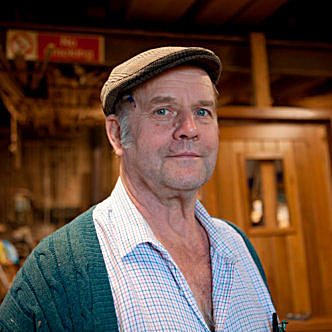
ANDRE & PEGGY PATTERSON
Andrew was born in 1918 as Andre Vizier at St Claud in the Charente Departement of the Nouvelle
Aquitaine region of France. His father was a member of the Maquis (the French Resistance) and
was made a Chevalier (Knight) of the Legion D’honneur having lost an arm during the first world
war.
At the outbreak of the second world war Andre joined the French Navy as a stoker. Following the
scuttling of the French fleet in November 1942 he eventually managed to join the British Navy.
At the end of the war Andre found himself in Liverpool as a Chief Petty Officer and, together with a
friend, was offered British nationality provided he changed his name. Looking out of the window they
saw a Carter Paterson (road haulage) lorry so Andre became Mr Andrew Paterson and his friend Mr
Carter!
Peggy was born on the 6
th
of June 1925. Her connection with Litton Cheney arises from her father
George Tompkins taking a dairy job with Col Wordsworth at Baglake – Peggy says he got the job
having told the Colonel that “he had been milking cows since he was 8, once before school and once
after”. The family lived at Riverside, Puddlehole as it was then known and Peggy’s Mum and Dad
continued to live there in retirement the arrangement with Col Wordsworth being that the cottage was
theirs for life plus 2 pints of milk a day and as much firewood as was needed.
Maybe the excitement of Litton Cheney during the war was insufficient
for young Peggy as she took herself off to Weymouth where she lived
with Gordon Moxom’s parents helping Gordon’s mother with the
running of her guest house there. This move proved a shrewd one for
Peggy as one of the lodgers turned out to be a dashing young French
sailor by the name of Andrew Paterson, recently transferred to the
Royal Navy from the French Navy. Despite the heavy bombing of
Weymouth and consequent move of Peggy back to Litton the entente
cordiale clearly survived the war and Peggy and Andrew were married
in 1945.
For the remaining 6 years of Andrew’s naval service they lived in
Portsmouth and then for a short while in Yeovil where Andrew got a job
with Westlands where he spent the rest of his working life.
In 1956 they moved to 1 Townsend Cottages, Litton Cheney, where
they lived together until Andrew’s death on the 6
th
of July 2007 aged 89
years. His memorial service was held at St Mary’s Church on the 13
th
of July.
Peggy died on the 19
th
of February 2018. Her memorial service was held at St Mary’s Church on the
16
th
of March.
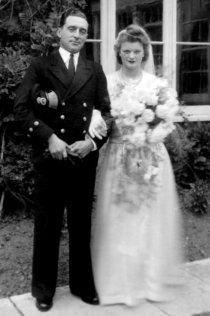
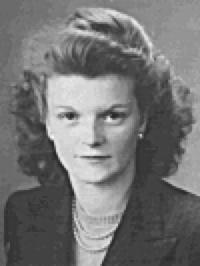
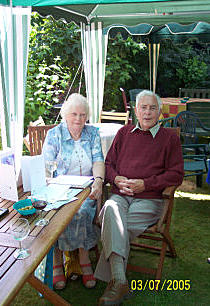
60th Anniversary Party
On behalf of our family - we thank you for coming to pay your respects today.
It is with a very heavy heart that Sophie and I stand here to say goodbye to our dear Nanny Bun. I am still not sure to this day
exactly why she was called Bun by our grandad but it was all Sophie and I ever knew and how we referred to her forevermore.
She was born in Swyre and worked for the local bakery with her father before going on to Marry our late grandad Gordon.
Following the establishment of Moxom Engineering she worked as a secretary. We don’t doubt that she kept them all in check
and well fed.
She was someone very special to us who played a significant role in shaping our lives. Although we lived further away in more
recent years, we were very lucky to be so close in proximity to her and grandad when we were growing up. From running around
the factory at Litton Cheney to playing on Chesil Beach, she was always there ready to greet us with open arms with a sweet
treat at the ready. We have fond memories of day trips to Dorchester, Poole and Devon with frequent trips to the garden centre in
Ottery St Mary, which, to our delight, always involved cake or ice-cream of some kind and a new toy. We certainly never went
hungry!
We’ll also never forget a magical trip to the Norwegian Fjords, remembering nanny in her finery and her brooches that she would
always wear for a special occasion. We were very lucky to have spent this time with her as well as countless Christmases and
birthdays where she never faltered in making us feel like the luckiest girls in the world.
Those that knew her will know of her kindness. She was down to earth with traditional values which very much felt like home for
Sophie and me. Making us feel so at ease, we could have told her anything without judgement. The door was always open with
the offer of tea and biscuits shortly following.
She leaves behind a beloved son, Alan, and her little great grandsons Harper and Rupert who we are so very glad she got to
meet. Sophie and I will ensure a bit of her lives on in them.
We’ll never forget your hugs, smile and legendry roast potatoes and hope you are now at peace with Grandad.
BARBARA MOXOM 1941-2024
By Her Grand-daughter Natalie
FUNERAL ADDRESS – Tuesday, 6
th
February 2024
